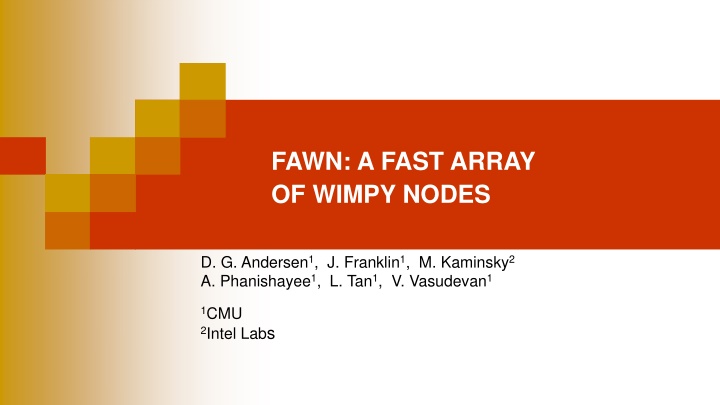Energy-Efficient Solution for I/O Workloads
This paper discusses FAWN, a fast array of wimpy nodes, designed to address energy consumption in online servers. It presents technical contributions such as consistent hashing and data log architecture to optimize I/O performance using low-power processors and flash storage. The goal is system rebalancing for efficiency, highlighting the benefits of flash storage over magnetic disks.
Download Presentation

Please find below an Image/Link to download the presentation.
The content on the website is provided AS IS for your information and personal use only. It may not be sold, licensed, or shared on other websites without obtaining consent from the author.If you encounter any issues during the download, it is possible that the publisher has removed the file from their server.
You are allowed to download the files provided on this website for personal or commercial use, subject to the condition that they are used lawfully. All files are the property of their respective owners.
The content on the website is provided AS IS for your information and personal use only. It may not be sold, licensed, or shared on other websites without obtaining consent from the author.
E N D
Presentation Transcript
FAWN: A FAST ARRAY OF WIMPY NODES D. G. Andersen1, J. Franklin1, M. Kaminsky2 A. Phanishayee1, L. Tan1, V. Vasudevan1 1CMU 2Intel Labs
Paper highlights An energy efficient solution for I/O intensive workloads Low-power processors Limited DRAM capacity All-flash storage Technical contributions Consistent hashing (as in Dynamo) Data log architecture
Motivation Need to limit energy consumption of online servers Environmental considerations Three-year TCO to be dominated by power Mismatch between 2009 architectures and needs of I/O-intensive workloads Fast and power hungry CPUs Large and power-hungry DRAM Slow and power-hungry magnetic disks
The problems Increasing CPU-I/O gap Faster CPUs Not so fast magnetic disks CPU power consumption grows super-linearly with speed More instructions per second Fewer instructions per Joule 108instructions/Joule for 2009 fastest CPUs 109instructions/Joule 2009 for lower- frequency in-order CPUs
The problems Dynamic power scaling on conventional architectures does not work A system running at 20% of its capacity still consume up to 50% of its peak power Powering on/off does not satisfy SLAs of most online workloads
Flash storage Fast random reads 1ms Up to 75 times faster than magnetic disks Power efficient Less than one Watt at full load Ten times less than magnetic disks Slow random writes Updating a single block requires erasing then rewriting a full erasure block (128 or 256 KB)
Data log architecture FAWN nodes have two constraints Small memory Poor performance of flash drives for random writes FAWN data log architecture Minimizes its RAM footprint All writes are append-only
Mapping a key to a value Through an in-memory hash table FAWN uses 160-bit keys: i least significant bits are index bits Next 15 low-order bits are key fragment Index bits are used to select a bucket Key fragment is stored in bucket entry 15 bits + valid bit + 32-bit data log address = 48 bits Key fragment Valid Data log address
The data log One data log per virtual node Data log entries consist of A full 160-bit key A length field The actual data Key (20B) Len Data
Basic data store functions Store: Adds an entry to the log and updates corresponding hash table entry Lookup: Locates a data log entry and checks full key Invalidate: Marks hash table entry invalid Adds a delete entry to the log (for durability)
Maintenance functions Split: Splits a data store between existing virtual node and a new virtual node Can take place while the data store is active All writes are appends Merge Merge two data stores into one Compact: Compacts data log and updates all hash table entries Similar to segment cleaning in LFS and F2FS
Impact of Virtual IDs As one physical node supports multiple virtual nodes Each virtual node has its own datalog Some writes are non-sequential Semi-random writes
Consistent hashing (I) Used in distributed hashing schemes to tolerate the loss of one or more servers Traditional approach: Organize key space as a ring Each server node corresponds to a single bucket Assign to each bucket a key value Bucket handles all key values higher than key value of precedcing bucket but lesser than its own key value. If a node dies, We lose a bucket
Consistent hashing (II) Have several buckets per node Nodes A, B and D have three buckets Node C has two buckets A1 B3 D3 B1 A3 C1 Each bucket has a successor Bucket B1 is successor of bucket A1 D1 B2 A2 D2 C2 If a bucket is unavailable Select next bucket
Consistent hashing (III) Potential problem Neighboring bucket will become overloaded Not if we associate with each physical node a set of random disjoint buckets: Virtual nodes When a physical node fails, its workload get shared by several other physical nodes
Explanation Ratio of query rate to data size defines the best solution These data reflect the 2009 state of the art Disk capacity Flash capacity
Conclusion Can provide both Low-energy consumption Fast response time for I/O-intensive workloads Thanks to Datalog architecture Efficient replication and fail-over























